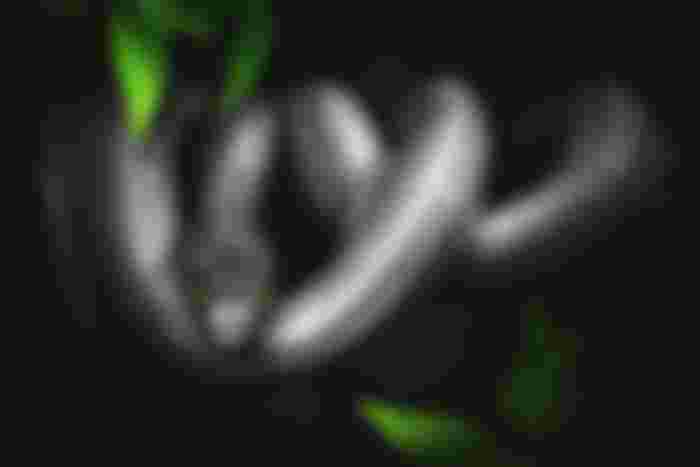The origin and evolution of snakes is a matter of dispute, but it seems relatively clear that they emerged in the Cretaceous period or earlier and that they descend from some form of lizard, possibly a venomous one. One hypothesis says from burrowing lizards, another from Mosasaurs, water-living reptiles. There is evidence supporting both hypotheses, but genetic studies raise more unanswered questions.
Eyesight of snakes varies between the very good to the very primitive, and it is impossible to say anything that is applicable to all snakes.
At least some of them have colour vision, although they can see less of the spectrum than humans do – how much they can see varies with species. They also have a yellow filter in the lens, protecting their eyes from ultra-violet light.
An interesting addition, however, is that pit vipers (a family of more than 150 different species, among others rattlesnakes, copperhead, and fer-de-lance) and boids (43 known species of two families: boas and pythons) have infra-red receptors in pits between eyes and nostrils, thus being able to “see” the body heat of their prey. They can follow a moving prey exactly on the basis of its temperature. (A pit viper can “see” changes in temperature as small as 0.002 centigrades!) Research suggests that their brain is creating a three-dimensional “picture” as a representation of these nervous stimuli. Whether this picture merges with the one created by “ordinary” vision is unknown but likely.
The sense of smell is well developed. They use their forked tongue to transport particles to the Jacobson's organ (a vomeronasal organ with chemoreceptors) for examination and analysis. This organ is situated in the mouth.
Then, of course, as can be expected from an animal who has so much of its body surface in contact with the ground, snakes are very sensitive to vibrations. This is related to hearing. Even lacking outer ears, they have inner ears with which they can hear low frequency vibrations in the air and register vibrations in the ground
If classified by dentition, snakes come in three types: constrictor, groove fanged, and hollow fanged.
Snakes with constrictor dentition, which are all non-venomous, have teeth like small hooks. Fanged snakes have two fangs amongst their teeth, which are fewer than with the constrictor type. The fangs serve to transport venom from the gland that produces it and into a prey the snake bites. For the flow, they either have a groove, or are hollowed, more like a needle.
Venom
The venoms of snakes are very complex chemical compounds, and some snakes, such as cobras, use a combination of venoms with different effects.
The venom can be proteolytic (e.g. cobra), strong digestive fluids beginning to dissolve the victim; a hemotoxin (from e.g. vipers and the genus naja), attacking the circulary system; a neurotoxin (from e.g. cobra, King cobra, sea snake), attacking the central nervous system; or a cytotoxin (from e.g. puff adder), attacking the cells. Cardiotoxins are a subgroup of the hemotoxins (from e.g. mamba, King cobra, the genus naja), especially attacking the heart.
It's not enough to avoid being bitten by snakes. A cobra can also spit venom over 2 meters into the eyes of a victim and cause temporary blindness, even permanent blindness if not treated. Cobra venom on unharmed skin, however, is not dangerous – but if the victim has an open wound it can enter the blood that way.
Another interesting venomous snake is the Bushmaster, Lachesis, a genus of highly venomous pit vipers. The venom is used as a medicine in homeopathy, a very useful preparation.
In my youth I read a book where a man had a basket with a bushmaster inside, a Lachesis muta, and he described it as the world's most deadly snake. Its venom, no doubt, is very dangerous, but the classification as most deadly might be disputed.
In the sense of having the most toxic venom, the inland taipan probably is number one, but it is not aggressive and hasn't caused any recorded human death.
Two strong candidates, however, are the Egyptian cobra, Naja haje, and the Indian King cobra, Ophiophagus hannah, the largest venomous snake in the world - both aggressive and highly toxic. Or why not puff adder, Bitis arietans; or some species of rattlesnake? It is hard to say because there is no objective standard to judge from.

Snake Charming
Contemporary snake charming – a threatened profession – is based on Indian tradition and practised mainly in and around India, but can sometimes be seen as far away as Morocco. Despite its modern decline into pure street entertainment, it originally was part of religious practices in connection with various Hindu snake gods, and with healing and medical practise.
Snake charming was also practised in Old Egypt. There, too, it was originally a religious or magical practise in connection with snake gods, and with the practise of medicine on how to treat snake bites. That tradition, however, is extinct. The snake charmers one can find in North Africa today, mainly in Morocco, have probably sprung from the Indian tradition, although it has merged with local traditions of magic and healing.
Perhaps we are seeing the last generation of snake charmers in India today. The practice is for many reasons less attractive than before. It has to do with protection of animals as well as a shrinking audience, since television and film provide the masses with a more varied entertainment.

Words & Etymology
Serpent means “limbless reptile” and has been used in English since around the year 1300. Ultimately it is derived from Sanskrit sarpa.
Although serpents and dragons are often confused in mythology, the distinction is very clear. A serpent is limbless, a dragon is not. Any creature with wings or legs or claws most certainly is not a serpent - but the term is sometimes erroneously used.
Snake is derived from old English snaca, which stems from Proto-Indo-European root snag, “to creep” or “crawl”. Snail has the same origin.
From another Proto-Indo-European root, netr-, comes another English word for snake: adder, via old English næddre.
The science of reptiles and amphibians is called herpetology. It is derived from Greek herpeton, meaning “creeping thing”. Thus a zoologist with herpetology as his speciality is called a herpetologist. The branch of herpetology which deals specifically with snakes is called ophiology or ophiodiology, and someone practising ophiology is called an ophiologist.
Ophidian, an adjective meaning “pertaining to snakes” comes from Greek ophidion, which is diminutive of ophis, a word meaning “serpent”. From that, the word ophiolatry, or ophiolatreia, "serpent-worship" has been created.
Ophidiophobia or ophiophobia is an abnormal fear of snakes. It can be so strong that a person suffering from it cannot even look at a picture of a snake. It's probably the world's most common phobia.
The words for serpent in the Hebrew original of Exodus 7:9-15 are tanniyn and nachash, but in Numbers 21:8-9 they are saraph and nachash. Interestingly, saraph also means seraphim.
In Sanskrit, naga is a word for snake, mainly a hooded snake, that is a cobra. Another Sanskrit word for snake is sarpa, from which “serpent” ultimately stems [see above].
Nachash-naga, saraph-sarpa. Are the similarities a coincidence?
(This article is based on material previously published in Meriondho Leo, and in my e-book “Serpents & Snakes”, 2019.)
Read the whole series:
1. From the Sacred Cobras of Egypt to Quezalcoatl: Serpents & Snakes in Mythology
2. Snakes in Astrology & Heraldry
Copyright © 2013, 2019, 2021 Meleonymica/Mictorrani. All Rights Reserved.
(The images are in the Public Domain)
My articles about natural science can be fund here, and about serpent & snakes here.
You find all my writings on Read.Cash, sorted by topic, here.
If you are interested in Natural Science, join my community Natural Science (1c4e)


Hey,
Informative, though when I read "Snakes in Real Life" my mind instinctively remembered my neighbour for some reason :P
She seems slippery as her husband is divorcing her, plus she is always badmouthing everybody, showing her venomous tongue :D
Just a little bit of fun. Cheers, and have a blast!